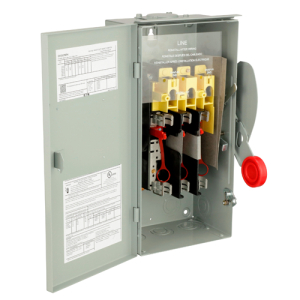In today’s world, where electricity is an indispensable part of daily life, its electrical safety implications cannot be ignored. Electrical hazards, such as shocks and fires, pose serious risks. According to the National Fire Protection Association (NFPA), electrical malfunctions are one of the leading causes of fires in commercial buildings, with thousands of incidents reported annually.
Enter safety switches, a device that has revolutionized the way we protect residential and commercial spaces from electrical hazards. Safety switches are fundamental components in electrical systems, crucial for maintaining electrical safety and circuit disconnection. These devices serve as vital safeguards in electrical power systems and as essential components for compliance with the NEC and NFPA standards. This guide explores the intricate world of safety switches, covering topics from their basic function to their diverse applications in commercial and industrial settings.
Need Safety Switches For Your Project?
Get Safety Switch QuoteSell To Us
Got Electrical Equipment You Don't Need?

Reduce Your Electrical Inventories & Earn Cash
Sell My EquipmentPanelboard
Need a Panelboard for Your Project/Job?

Our Experienced Sales Engineers Can Help Design the Right Panelboard For You
Learn MoreTransformer Oil Testing
Is Your Transformer Due For Servicing?

Get Your Oil Analysis & Fluid Testing Done By Our NETA-Certified Techs
Learn MoreElectrical Product Resources
Product Training Product Safety Product Guides Product News Featured ProductsPurpose of Safety Switches
Safety switches are designed with two primary purposes in mind, both crucial for the safe operation of electrical systems:
1. As a Disconnecting Means for a Service Entrance: In this role, safety switches serve as the central control point for turning off the power supply to a building or facility. This function is vital during emergencies, maintenance, or when modifications are needed in the electrical system.
2. As a Disconnecting Means and Fault Protection for Motors: Safety switches also play a pivotal role in providing overcurrent protection for motor circuits. This function is essential for preventing motor faults and ensuring the safe operation and maintenance of motor-driven equipment.
Regulations and Compliance
NEC Requirements
The National Electrical Code (NEC) sets specific requirements for installing and operating safety switches. These standards ensure that safety switches meet the highest safety criteria for electrical installations. The NEC covers various aspects, including specifications for installation in service entrances, motor circuits, and guidelines for their placement and accessibility.
Visibility and Location Standards
Safety switches must be easily accessible and visible. The NEC and NFPA provide clear guidelines for placing safety switches to ensure they can be quickly located and operated in emergencies. Proper visibility and accessibility are crucial for both safety and compliance.
Types of Safety Switches
Safety switches come in various types, each designed for specific applications and settings.
Fusible vs. Non-Fusible Safety Switches
1. Non-Fusible Safety Switch: These switches are pivotal in applications requiring simple circuit disconnection without the need for overcurrent protection. Their straightforward design makes them ideal for settings where circuit protection is managed separately or not needed. These switches are known for their reliability and ease of use.
2. Fusible Safety Switch: These switches combine a switch with fuses in a single enclosure. These switches offer both manual circuit control and overcurrent protection. They are integral in environments where overcurrent protection is a priority, alongside circuit disconnection.
General Duty Safety Switch
GD safety switches are designed for residential and light commercial applications. They are typically used in low-voltage distribution systems. These switches are an excellent choice for small-scale operations that do not require the robust features of heavy-duty switches.
Heavy-Duty Safety Switch
This type of switch is tailored for more demanding commercial and industrial applications. These switches often come with additional features like surge protection and shunt trip mechanisms, enhancing their safety and functionality. Heavy-duty safety switches are built to withstand harsh conditions and are often used in environments where reliability and durability are critical.
Double Throw Safety Switch
Double-throw safety switches are essential in applications that require a manual transfer switch. These switches are commonly used with portable generators and emergency power systems. They provide a reliable means to switch between different power sources, ensuring continuous power supply during outages or maintenance.

Specialty Safety Switches
Specialty safety switches are designed for specific applications and offer unique features to cater to particular needs:
1. Quick Connect Safety Switch: Designed for scenarios where rapid power disconnection is critical. They are often used in emergency systems where time is of the essence.
2. Elevator Control Switch: Specially designed for elevator control circuits, these switches ensure the safe operation and maintenance of elevator systems.
3. Double Door Safety Switch: Enhanced protection for larger electrical systems. Ideal for complex installations requiring higher levels of safety and control.4. Line Isolation Safety Switch: Used predominantly in hospitals and medical facilities. Crucial for isolating power lines during maintenance or in emergencies, ensuring personnel and patients’ safety.
NEMA Enclosure Ratings
Understanding the NEMA Enclosure Ratings is vital for selecting the correct safety switch for different environmental conditions:
| Type 1 | Suitable for general indoor use | Provides basic protection against dust and light debris. |
| Type 3R | Suitable for outdoor use | Resistant to weather elements and protect against rain, snow, and sleet. |
| Type 4/4X | Suitable for wet locations | Offer protection against water ingress, making them suitable for both indoor and outdoor use in moist environments. |
| Type 12 | Dust-tight and suitable for industrial settings | Protects against dust, dirt, and other airborne particles. |
Application in Various Sectors
Safety switches are used across various sectors, each with its specific requirements and challenges:
Healthcare
In medical facilities, safety switches are crucial for maintaining power supply reliability and ensuring patient safety.
Heavy Industries
In industrial settings, heavy-duty safety switches manage high-power equipment, providing robust performance and enhanced safety features.
Commercial Buildings
General duty safety switches are commonly used for lighting and small-scale power distribution in commercial buildings.
These varied applications are guided by NEC requirements, ensuring safety and reliability in motor circuits and service entrances across sectors.
Custom Safety Switches
Manufacturers like Siemens and Eaton offer customization options for safety switches, tailoring them to meet specific industry needs. Custom safety switches can feature enhanced reliability designs, safer operational features, and adaptations for specific environmental conditions. This customization ensures that safety switches meet the unique demands of various industrial, commercial, and residential applications.
Top 10 Frequently Asked Questions
NOTE: This post is for educational purposes only. Electrical systems can be hazardous, and working with them without the necessary expertise and training can be dangerous. We recommend getting the assistance of a certified electrical professional if you’re not already a qualified electrician. Performing electrical work without the needed knowledge and training may lead to severe injuries, electric shocks, or damage to the equipment. Always prioritize safety and, when in doubt, contact a qualified electrician.
